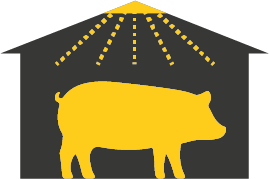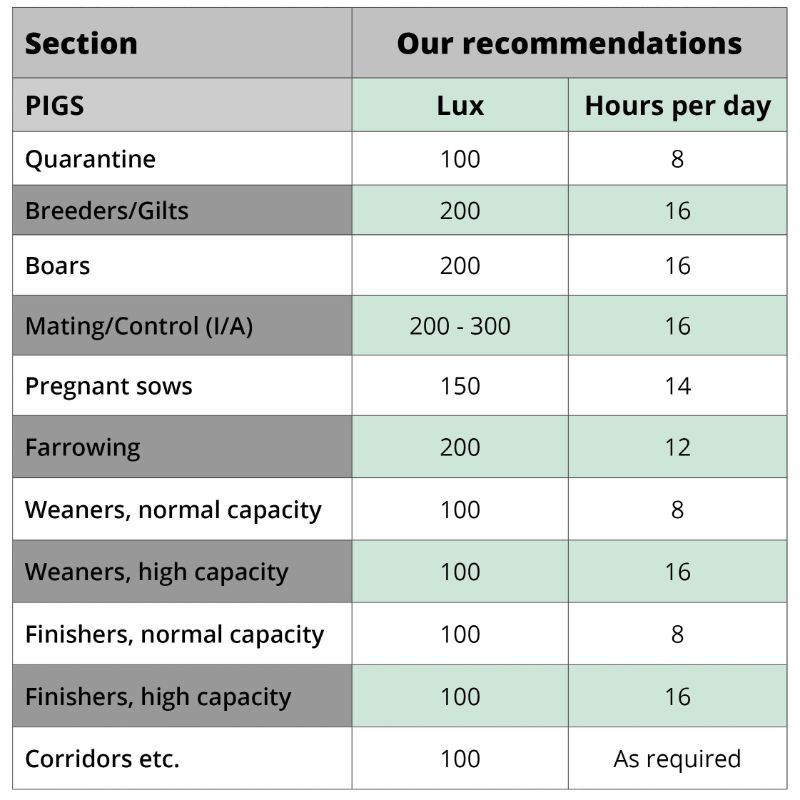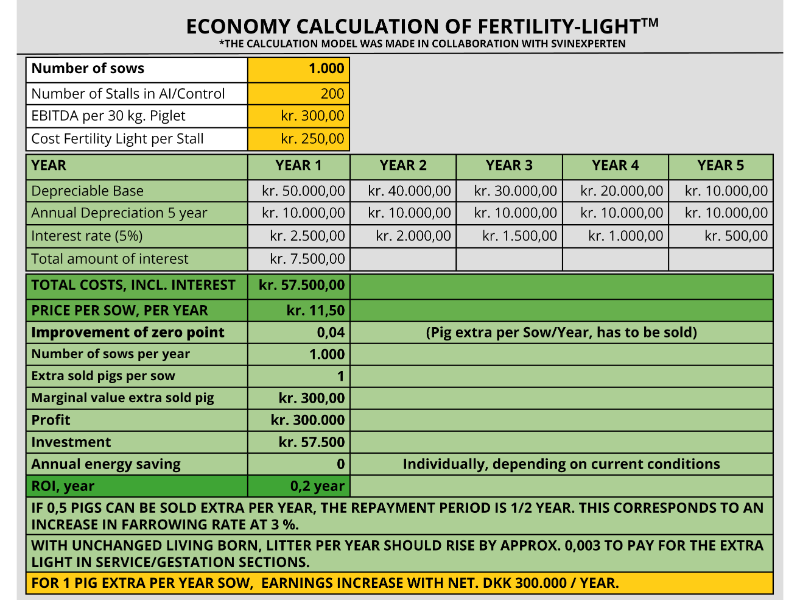INCREASE PRODUCTIVITY IN YOUR PIG PRODUCTION WITH LED LIGHTING
Unpacking and mounting the lighting in the stable took a total of 2.5 hours.
PIG HOUSE
Better animal welfare and increased productivity with the right lighting
Achieve better welfare for animals and humans with LED stable lighting from RN Solutions. The lighting meets the recommendations of veterinarians and leading international consultants.
With the correct lighting in the pigsty, the sows will act as if it were spring all year round, and in this way, the seasonal fluctuations can be reduced.
WITH RN SOLUTIONS' SPECIALLY DEVELOPED LIGHTING CONCEPTS FOR PIGSTIES, YOU GET:
- Optimal lighting (200-400 lux) through stable fixtures mounted directly above the sows' heads
- Easy installation - either with RN Solutions' cost-effective RNS Plug 'N Play™ solution with easy and quick mounting, or with RN Solutions' fixtures for permanent installation with PUSH-IN clamps
- Significant savings on the electricity bill - typically 50-80% per year depending on the current lighting
- Long-lasting and robust solution
CAN WE OPTIMIZE THE SOWS' PRODUCTIVITY WITH CHANGED LIGHT INFLUENCE:
Darkness increases melatonin production in the brain, and light inhibits it. Therefore, both light and darkness are important for maintaining a regular circadian rhythm. The hormone melatonin is called the "darkness hormone" because it is produced when it is dark, such as at night, and to a greater extent in the winter than in the summer, if not supplemented with daylight.
A disrupted circadian rhythm occurs when there is too little light during the day and/or if it is light at night. - Thus, the boundaries between day and night are blurred, and this negatively affects fertility, lifespan, and overall health. Light increases prolactin secretion, which in turn increases the growth hormone IGF-1, and in the udder, it helps to reduce cell death and stimulates cell growth and milk synthesis.
Our LED lighting concepts for pigs:
Recommended products:
RNS Plug 'N Play™
FIXED INSTALLATION
LED HIGH BAY
LIGHT CONTROL AND DIMMER
Lux Recommendations
Our lux recommendations are based on more than 10 years of experience with lighting for cattle.
We have gathered extensive knowledge from various institutions such as Seges, DTU, various consultants and international universities, veterinarians, and other lighting companies, but not least practical concrete experiences from several thousand pig producers.
With the right lighting level, we can:
- Improve reproduction
- Increase the sows' productivity as well as increase growth in young animals
- Other side effects - health and better observation conditions
- Better working environment
This often requires:
- Greater amount of light and thus more light sources
The additional cost for LED lighting was minimal, in part due to the quick installation of the RNS Plug 'N Play™ system fixtures.
Improves reproduction in gestation/control houses
FERTILITY-LIGHT™
Improves reproduction in mating/control stables by the correct placement of stable lighting
With the correct lighting of the sows, better estrus is achieved, thereby preventing returns, abortions, and empty sows. Often an increased litter size is also seen.
With FERTILITY-LIGHT™, the fixtures are mounted directly above the sows' heads, so that the sows are illuminated with 200-400 lux. This results in the sows acting as if it were summer all year round, and you will therefore achieve improvements such as:
- More sows coming into estrus
- 2-5% higher farrowing rate
- 0.3-1 extra pig per litter
- The investment is paid back in approximately 3 months
Recommended products:
FERTILITY-LIGHT™
ACCESSORIES
Our LED lighting concepts for pigs:
ECONOMIC CALCULATION OF FERTILITY-LIGHT™
Improves reproduction in gestation/control houses through correct placement of lighting.
At RN Solutions, we want you to have a full overview of the profit you can achieve by installing FERTILITY-LIGHT™ in your stable. We therefore offer a free and non-binding economic calculation*.
Example of a calculation for 5 weeks of stabling in a mating/control stable:
The calculation gives you, among other things, an overview of
- Number of extra piglets sold per sow
- Profit
- Return of Investment
- The total investment
- Annual energy savings (individual, depending on current conditions)
Our LED lighting concepts for pigs:
Colored LED lighting specifically designed for pigs
Since 2008, ONCE® has made large investments in the development, testing, and trial of LED colored lights for Pig Houses.
DIM-TO-RED®
Colored LED lighting specifically designed for pigs
Dim-to-Red® is a combination light, consisting of white light diodes and diodes of other colors. When dimmed to below 40%, the light will be red alone.

Pigs perceive red light as darkness
Incorrect lighting can have a negative effect on pig health, production, and overall animal welfare. Pigs see light much more dimly than humans. Their vision is dichromatic, which means they can only distinguish two colors - green and blue. Pigs' eyes are also least sensitive to the color red, which they almost do not see. Therefore, the pigs perceive the red light from Dim-to-Red® as darkness.
Dim-to-Red® reduces stress, improves animal welfare, and stimulates reproduction
Dim-to-Red® light recreates the pigs' natural environment, where the extreme change in light is eliminated by simulating a natural sunrise and sunset. Extreme changes in light when turning on and off have a negative effect on the animals' stress level and overall welfare. By using Dim-to-Red® light, which provides even lighting, stress markers are minimized and animal welfare is improved.
Furthermore, the simulation of a circadian rhythm promotes the formation of melatonin. When no white light enters the eye, more melatonin is formed. Melatonin helps regulate the circadian rhythm and hormones in the body and is also a strong antioxidant, which helps to strengthen the immune system and overall health.
Research shows that a day length of 12 to 16 hour followed by at least 8 hours of night period is most beneficial for pigs, while a 15 to 16 hour day length is best in breeding houses. In piglet and slaughter pig houses, complete darkness is recommended for 8 hours with 30 minutes of sunrise/sunset simulation to reduce stress that can arise from a sudden change in light. There is a legal requirement for pigs to have a day length of at least 8 hours and a night period of at least 8 hours.
The red light helps with night work
Research further shows that night lights can also disrupt the hormonal cycle in pigs. It is clear that even dimmed white night light has a negative effect on the pigs, so only red light should be used during dark periods. This makes Dim-to-Red® highly useful in farrowing stables, so that one does not need to turn on the white light during nighttime monitoring and night work
Recommended products:
DIM-TO-RED®
Our LED lighting concepts for pigs:
Dim-to-Red® has, among other things, a positive effect on reducing tail biting and mortality, as well as optimizing the boar's sperm production.
Clear improvement in the quality and quantity of boar sperm production
Research shows that boar sperm production is seasonal and related to the light in the animal's surroundings, which regulates the level of melatonin. There is a direct link between melatonin production and sperm production, and manipulation of day length can be an effective tool in improving sperm production. Melatonin has a clear effect on the quality and quantity of boar sperm.
Furthermore, studies show that boars are most productive in the fall/winter and least productive in the spring/summer. This means that light programs with decreasing day length provide the best insemination doses.
Dim-to-Red® technology allows the fixtures to dim to full red light, which pigs perceive as darkness. This enables sunrise and sunset functionality that reduces stress. It also provides red service light, allowing workers to have continuous access to the facility without disturbing or interrupting the pigs' sleep cycle.
When using the lighting concept DIM-TO-RED®, you will get:
- Need-based lighting, which improves animal welfare
- Less stress among the pigs
- Increased reproduction
- Reduces tail biting
- Lower mortality among nursing piglets - fewer nursing piglets are killed by the sow
- Improved immunity and lower mortality
- Light ideal for night work - as pigs perceive red light as darkness
- Flicker-free light and 0-100% dimmable
- LED diodes provide low energy consumption - significant savings on the electricity bill and CO2 footprint
- Robust long-lasting solution
- 50.000 - 88.000 hours of lifespan
- Build For Your Barn® - can withstand dust, high-pressure cleaning, and various gases, including ammonia






